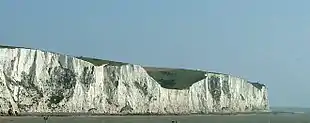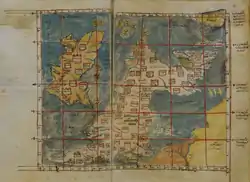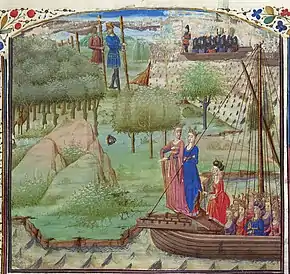Albion
Albion is an alternative name for Britain. It is sometimes used poetically to refer to the island, but has fallen out of common use in English. The name for Scotland in most of the Celtic languages is related to Albion: Alba in Scottish Gaelic, Albain (genitive Alban) in Irish, Nalbin in Manx and Alban in Welsh and Cornish. These names were later Latinised as Albania and Anglicised as Albany, which were once alternative names for Scotland.

New Albion and Albionoria ("Albion of the North") were briefly suggested as names of Canada during the period of the Canadian Confederation.[1][2] Arthur Phillip, first leader of the colonisation of Australia, originally named Sydney Cove "New Albion", but later the colony acquired the name "Sydney".[3][4][5] Sir Francis Drake gave the name New Albion to what is now California when he landed there in 1579.
Etymology

The Common Brittonic name for the island, Hellenised as Albíōn (Ἀλβίων)[6] and Latinised as Albiōn (genitive Albionis), derives from the Proto-Celtic nasal stem *Albiyū (oblique *Albiyon-) and survived in Old Irish as Albu (genitive Albann). The name originally referred to Britain as a whole, but was later restricted to Caledonia (giving the modern Scottish Gaelic name for Scotland: Alba). The root *albiyo- is also found in Gaulish and Galatian albio- 'world' and Welsh elfydd (Old Welsh elbid 'earth, world, land, country, district'). It may be related to other European and Mediterranean toponyms such as Alpes, Albania or the river god Alpheus (originally 'whitish'). It has two possible etymologies: either from the Proto-Indo-European word *albʰo- 'white' (cf. Ancient Greek ἀλφός, Latin albus ), or from *alb- 'hill'. The derivation from a word for 'white' is thought to be perhaps in reference to the white southern shores of the island – visible from mainland Europe and a landmark at the narrowest crossing point –, though Celtic linguist Xavier Delamarre argued that it originally meant 'the world above, the visible world', in opposition to 'the world below', i.e. the underworld.[7][8][9]
Attestation
Judging from Avienus' Ora Maritima, for which it is considered to have served as a source, the Massaliote Periplus (originally written in the 6th century BC, translated by Avienus at the end of the 4th century AD), does not use the name Britannia; instead it speaks of nēsos Iernōn kai Albiōnōn "the islands of the Iernians and the Albiones".[10] Likewise, Pytheas (c. 320 BC), as directly or indirectly quoted in the surviving excerpts of his works in later writers, speaks of Albiōn and Iernē (Britain and Ireland). Pytheas's grasp of the νῆσος Πρεττανική (nēsos Prettanikē, "Prettanic island") is somewhat blurry, and appears to include anything he considers a western island, including Thule.[11]
The name Albion was used by Isidore of Charax (1st century BC – 1st century AD)[12] and subsequently by many classical writers. By the 1st century AD, the name refers unequivocally to Great Britain. But this "enigmatic name for Britain, revived much later by Romantic poets like William Blake, did not remain popular among Greek writers. It was soon replaced by Πρεττανία (Prettanía) and Βρεττανία (Brettanía 'Britain'), Βρεττανός (Brettanós 'Briton'), and Βρεττανικός (Brettanikós, meaning the adjective British). From these words the Romans derived the Latin forms Britannia, Britannus, and Britannicus respectively".[13]
The Pseudo-Aristotelian text On the Universe (393b) has:
Ἐν τούτῳ γε μὴν νῆσοι μέγισται τυγχάνουσιν οὖσαι δύο, Βρεττανικαὶ λεγόμεναι, Ἀλβίων καὶ Ἰέρνη
There are two very large islands in it, called the British Isles, Albion and Ierne.[14] (Britain and Ireland).
Pliny the Elder, in his Natural History (4.16.102) likewise has:
It was itself named Albion, while all the islands about which we shall soon briefly speak were called the Britanniae.[15][16]
In his 2nd century Geography, Ptolemy uses the name Ἀλουΐων (Alouiōn, "Albion") instead of the Roman name Britannia, possibly following the commentaries of Marinus of Tyre.[17] He calls both Albion and Ierne νῆσοι Βρεττανικαὶ (nēsoi Brettanikai, "British Isles").[18][19]
In 930, the English king Æthelstan used the title Rex et primicerius totius Albionis regni ("King and chief of the whole realm of Albion").[20] His nephew, Edgar the Peaceful, styled himself Totius Albionis imperator augustus "Augustus Emperor of all Albion" in 970.[21]
The giants of Albion

A legend exists in various forms that giants were either the original inhabitants, or the founders of the land named Albion.
Geoffrey of Monmouth
According to the 12th-century Historia Regum Britanniae ("The History of The Kings of Britain") by Geoffrey of Monmouth, the exiled Brutus of Troy was told by the goddess Diana;
Brutus! there lies beyond the Gallic bounds
An island which the western sea surrounds,
By giants once possessed, now few remain
To bar thy entrance, or obstruct thy reign.
To reach that happy shore thy sails employ
There fate decrees to raise a second Troy
And found an empire in thy royal line,
Which time shall ne'er destroy, nor bounds confine.— Geoffrey of Monmouth, History of the Kings of Britain/Books 1, 11
After many adventures, Brutus and his fellow Trojans escape from Gaul and "set sail with a fair wind towards the promised island".[22]
"The island was then called Albion, and inhabited by none but a few giants. Notwithstanding this, the pleasant situation of the places, the plenty of rivers abounding with fish, and the engaging prospect of its woods, made Brutus and his company very desirous to fix their habitation in it." After dividing up the island between themselves "at last Brutus called the island after his own name Britain, and his companions Britons; for by these means he desired to perpetuate the memory of his name".[23] Geoffrey goes on to recount how the last of the giants are defeated, the largest one called Goëmagot is flung over a cliff by Corineus.
Anglo-Norman Albina story
Later, in the 14th century, a more elaborate tale was developed, claiming that Albina and her sisters founded Albion and procreated there a race of giants.[24] The "Albina story" survives in several forms, including the octosyllabic Anglo-Norman poem "Des grantz geanz" dating to 1300–1334.[25][lower-alpha 1][26][27][lower-alpha 2][29] According to the poem, in the 3970th year of the creation of the world,[lower-alpha 3] a king of Greece married his thirty daughters into royalty, but the haughty brides colluded to eliminate their husbands so they would be subservient to no one. The youngest would not be party to the crime and divulged the plot, so the other princesses were confined to an unsteerable rudderless ship and set adrift, and after three days reached an uninhabited land later to be known as "Britain". The eldest daughter Albina (Albine) was the first to step ashore and lay claim to the land, naming it after herself. At first, the women gathered acorns and fruits, but once they learned to hunt and obtain meat, it aroused their lecherous desires. As no other humans inhabited the land, they mated with evil spirits called "incubi", and subsequently with the sons they begot, engendering a race of giants. These giants are evidenced by huge bones which are unearthed. Brutus arrived 260 years after Albina, 1136 before the birth of Christ, but by then there were only 24 giants left, due to inner strife.[29] As with Geoffrey of Monmouth's version, Brutus's band subsequently overtake the land, defeating Gogmagog in the process.[29]
Manuscripts and forms
The octosyllabic poem appears as a prologue to 16 out of 26 manuscripts of the Short Version of the Anglo-Norman prose Brut, which derives from Wace. Octosyllabic is not the only form the Anglo-Norman Des Grantz Geanz, there are five forms, the others being: the alexandrine, prose, short verse, and short prose versions.[25][30] The Latin adaptation of the Albina story, De Origine Gigantum, appeared soon later, in the 1330s.[31] It has been edited by Carey & Crick (1995),[32] and translated by Ruth Evans (1998).[33]
Diocletian's daughters
A variant tale occurs in the Middle English prose Brut (Brie ed., The Brut or the Chronicles of England 1906–1908) of the 14th century, an English rendition of the Anglo-Norman Brut deriving from Wace.[lower-alpha 4][34][35] In the Prolog of this chronicle, it was King "Dioclician" of "Surrey" (Syria[36]), who had 33 daughters, the eldest being called "Albyne". The princesses are all banished to Albion after plotting to murder their husbands, where they couple with the local demons; their offspring became a race of giants. The chronicle asserts that during the voyage Albyne entrusted the fate of the sisters to "Appolyn," which was the god of their faith. The Syrian king who was her father sounds much like a Roman emperor,[36] though Diocletian (3rd century) would be anachronistic, and Holinshed [37] explains this as a bungling of the legend of Danaus and his fifty daughters who founded Argos.
Later treatment of the myth
Because Geoffrey of Monmouth's work was regarded as fact until the late 17th century, the story appears in most early histories of Britain. Wace, Layamon, Raphael Holinshed, William Camden and John Milton repeat the legend and it appears in Edmund Spenser's The Faerie Queene.[38]
William Blake's poems Milton and Jerusalem feature Albion as an archetypal giant representing humanity.
In 2010, artist Mark Sheeky donated the 2008 painting "Two Roman Legionaries Discovering The God-King Albion Turned Into Stone" to the Grosvenor Museum collection.[39]
See also
- Britain (place name)
- Terminology of the British Isles
- Perfidious Albion
- Nordalbingia, based on the Latin name for the Elbe River: Alba
- New Albion
Notes
- Brereton 1937, p. xxxii had allowed for earlier dating range, giving 1200 (more likely 1250) to 1333/4: "not earlier than the beginning – probably not before the middle – of the thirteenth century and not later than 1333–4"
- The same text (same MS source) as Jubinal (Cotton Cleopatra IX) occurs in Francisque Michel ed., Gesta Regum Britanniae (1862), under the Latin title De Primis Inhabitatoribus Angliæ and incipit.[28]
- Brereton 1937, p. 2, "Del mound, treis mil e nef cent/E sessante e diz ans" ll.14–15; but "treis" is lacking in Michel 1862 so that it reads "1970 years"
- In the Anglo-Norman prose Brut, the poem prefaced to the Short Version was incorporated to the text proper (prologue) of the Long Version, from the long version. This long version was then rendered into Middle English.Lamont 2007, p. 74
References
- "How Canada Got Its Name". about.com. Archived from the original on 7 December 2010. Retrieved 3 May 2018.
- Rayburn, Alan (2001). Naming Canada: Stories about Canadian Place Names. University of Toronto Press. p. 16. ISBN 978-0-8020-8293-0.
- Rosalind Miles (2001) Who Cooked the Last Supper: The Women's History of the World Three Rivers Press. ISBN 0-609-80695-5
- "Archived copy". Archived from the original on 2016-05-12. Retrieved 2016-05-10.CS1 maint: archived copy as title (link)
- 1414, scheme=AGLSTERMS.AglsAgent; corporateName=State Library of New South Wales; address=Macquarie Street, Sydney, NSW 2000; contact=+61 2 9273 (10 September 2015). "Stories". State Library of NSW. Archived from the original on 2013-02-03. Retrieved 3 May 2018.CS1 maint: numeric names: authors list (link)
- Ancient Greek "... ἐν τούτῳ γε μὴν νῆσοι μέγιστοι τυγχάνουσιν οὖσαι δύο, Βρεττανικαὶ λεγόμεναι, Ἀλβίων καὶ Ἰέρνη, ...", transliteration "... en toutôi ge mên nêsoi megistoi tynchanousin ousai dyo, Brettanikai legomenai, Albiôn kai Iernê, ...", Aristotle: On Sophistical Refutations. On Coming-to-be and Passing Away. On the Cosmos., 393b, pages 360–361, Loeb Classical Library No. 400, London William Heinemann LTD, Cambridge, Massachusetts University Press MCMLV
- Freeman, Philip; Koch, John T. (2006). Koch, John T. (ed.). Celtic Culture, ABC–CLIO. pp. 38–39.
- Delamarre, Xavier (2003). Dictionnaire de la langue gauloise (2nd ed.). Errance. pp. 37–38.
- Ekwall, Eilert (1930). "Early names of Britain". Antiquity. 4 (14): 149–156. doi:10.1017/S0003598X00004464.
- Avienus' Ora Maritima, verses 111–112, i.e. eamque late gens Hiernorum colit; propinqua rursus insula Albionum patet.
- G. F. Unger, Rhein. Mus. xxxviii., 1883, pp. 1561–1596.
- Scymnus; Messenius Dicaearchus; Scylax of Caryanda (1840). Fragments des poemes géographiques de Scymnus de Chio et du faux Dicéarque, restitués principalement d'après un manuscrit de la Bibliothèque royale: précédés d'observations littéraires et critiques sur ces fragments; sur Scylax, Marcien d'Héraclée, Isidore de Charax, le stadiasme de la Méditerranée; pour servir de suite et de supplément à toutos les éditions des petits géographes grecs. Gide. p. 299.
- Snyder, Christopher A. (2003). The Britons. Blackwell Publishing. p. 12. ISBN 0-631-22260-X.
- Aristotle or Pseudo-Aristotle; E. S. Forster (translator); D. J. Furley (translator) (1955). "On the Cosmos, 393b12". On Sophistical Refutations. On Coming-to-be and Passing Away. On the Cosmos. William Heinemann, Harvard University Press. pp. 360–361. at the Open Library Project.DjVu
- Pliny the Elder's Naturalis Historia Book IV. Chapter XLI Latin text Archived 2014-07-19 at the Wayback Machine and English translation Archived 2013-05-17 at the Wayback Machine at the Perseus Project. See also Pliny's Natural history. In thirty-seven books at the Internet Archive.
- Charlton T. Lewis, Charles Short, A Latin Dictionary, lemma Britanni Archived 2016-03-05 at the Wayback Machine II.A at the Perseus Project.
- Ptolemy's Geographia, Book II – Didactic Analysis Archived 2011-07-27 at the Wayback Machine, COMTEXT4
- Claudius Ptolemy (1843). "index of book II" (PDF). In Nobbe, Carolus Fridericus Augustus (ed.). Claudii Ptolemaei Geographia. vol.1. Leipzig: sumptibus et typis Caroli Tauchnitii. p. 59. Archived (PDF) from the original on 2013-12-08.
- Βρεττανική. Liddell, Henry George; Scott, Robert; A Greek–English Lexicon at the Perseus Project
- England: Anglo-Saxon Royal Styles: 871–1066, Anglo-Saxon Royal Styles (9th–11th centuries) Archived 2010-09-27 at the Wayback Machine, archontology.org
- Walter de Gray Birch, Index of the Styles and Titles of Sovereigns of England, 1885
- History of the Kings of Britain/Book 1, 15
- History of the Kings of Britain/Book 1, 16
- Bernau 2007
- Dean, Ruth (1999), Anglo-Norman Literature: A Guide to Texts and Manuscripts, pp. 26–30, cited by Fisher, Matthew (2004). Once Called Albion: The Composition and Transmission of History Writing in England, 1280–1350 (Thesis). Oxford University. p. 25. Archived from the original on 2014-03-09.. Fisher: "five distinct versions of Des Grantz Geanz: the octosyllabic, alexandrine, prose, short verse, and short prose versions survive in 34 manuscripts, ranging in date from the first third of the fourteenth to the second half of the fifteenth century"
- Brereton 1937
- Jubinal 1842, pp. 354–371
- Michel 1862, pp. 199–254
- Barber 2004
- Wogan-Browne, Jocelyn (2011), Leyser, Conrad; Smith, Lesley (eds.), "Mother or Stepmother to History? Joan de Mohun and Her Chronicle", Motherhood, Religion, and Society in Medieval Europe, 400–1400, Ashgate Publishing, p. 306, ISBN 978-1409431459
- Carley & Crick 1995, p. 41
- Carley & Crick 1995
- Evans 1998
- Brie 1906–1908
- Bernau 2007, p. 106
- Baswell, Christopher (2009), Brown, Peter (ed.), "English Literature and the Classical Past", A Companion To Medieval English Literature and Culture, c.1350–c.1500, John Wiley & Sons, pp. 242–243, ISBN 978-1405195522
- Historie of England 1587, Book 1, Chapter 3
- Harper, Carrie Anne (1964). The Sources of the British Chronicle History in Spenser's Faerie Queene. Haskell House. pp. 48–49.
- "Chester Grosvenor Art competition: winners". Cheshire Today. Archived from the original on 20 October 2016. Retrieved 20 October 2016.
Bibliography
Albina story
- Jubinal, Achille, ed. (1842), "Des graunz Jaianz ki primes conquistrent Bretaingne (Bibl. Cotton Cleopatra D IX)", Nouveau recueil de contes, dits, fabliaux et autres pièces inédites des XIIIe, XIVe et XVe siècles, pour faite suite aux collections de Legrand d'Aussy, Barbazan et Méon, Pannier, pp. 354–371
- Michel, Francisque, ed. (1862), "Appendix I: De Primis Inhabitatoribus Angliæ", Gesta Regum Britanniæ: a metrical history of the Britions of the XIIIth century, Printed by G. Gounouilhou, pp. 199–214
- Barber, Richard, ed. (2004) [1999], "1. The Giants of the Island of Albion", Myths & Legends of the British Isles, Boydell Press
- Brie, Friedrich W. D., ed. (1906–1908), The Brut or the Chronicles of England ... from Ms. Raw. B171, Bodleian Library, &c., EETS o.s., 131 (part 1), London
- Carley, James P.; Crick, Julia (1995), Carley; Riddy, Felicity (eds.), "Constructing Albion's Past: An Annotated Edition of De origine gigantum", Arthurian Literature XIII, D. S. Brewer, pp. 41–115, ISBN 0859914496
- Evans, Ruth (1998), Carley; Riddy, Felicity (eds.), "Gigantic Origins: An Annotated Translation of De origine gigantum", Arthurian Literature XVI, D. S. Brewer, pp. 197–217, ISBN 085991531X
- Lamont, Margaret Elizabeth (2007), "Albina, her sisters, and the giants of Albion", The "Kynde Bloode of Engeland": Remaking Englishness in the Middle English Prose "Brut", pp. 73ff, ISBN 978-0549482543
Studies
- Bernau, Anke (2007), McMullan, Gordon; Matthews, David (eds.), "Myths of origin and the struggle over nationhood", Reading the Medieval in Early Modern England, Cambridge University Press, pp. 106–118, ISBN 978-0521868433
- Brereton, Georgine Elizabeth, ed. (1937), Des grantz geanz: an Anglo-Norman poem, Medium Aevum Monographs, 2, Oxford: Blackwell